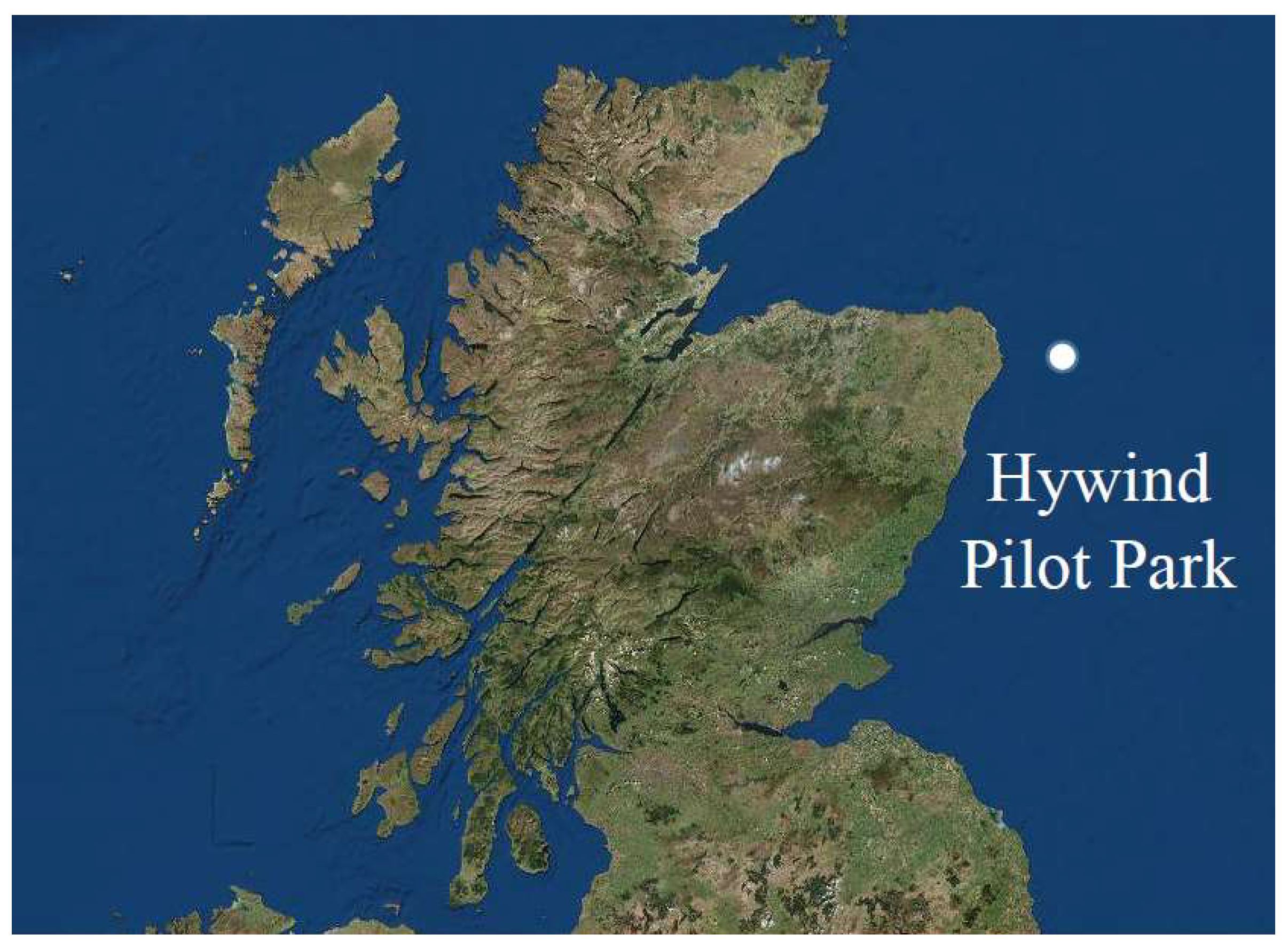5 MW Wind Turbine Annual Energy Production Improvement by Flow Control Devices †
Abstract
:1. Introduction
2. Wind Turbine Location
3. Annual Wind Speed Characterization
4. Simulation of Wind Turbine Energy Production
5. Conclusions
Author Contributions
Acknowledgments
Conflicts of Interest
References
- Johnson, S.J.; van Dam, C.P. Active Load Control Techniques for Wind Turbines; SAND2008-4809; Sandia National Laboratories: Livermore, CA, USA, 2008. [Google Scholar]
- Fernandez-Gamiz, U.; Velte, C.M.; Réthoré, P.; Sørensen, N.N.; Egusquiza, E. Testing of self-similarity and helical symmetry in vortex generator flow simulations. Wind Energy 2016, 19, 1043–1052. [Google Scholar] [CrossRef]
- Martínez-Filgueira, P.; Fernandez-Gamiz, U.; Zulueta, E.; Errasti, I.; Fernandez-Gauna, B. Parametric study of low-profile vortex generators. Int. J. Hydrogen. Energy 2017, 42, 17700–17712. [Google Scholar] [CrossRef]
- Aramendia-Iradi, I.; Fernandez-Gamiz, U.; Sancho-Saiz, J.; Zulueta-Guerrero, E. State of the art of active and passive flow control devices for wind turbines. Dyna 2016, 91, 512–516. [Google Scholar]
- Aramendia, I.; Fernandez-Gamiz, U.; Ramos-Hernanz, J.; Sancho, J.; Lopez-Guede, J.M.; Zulueta, E. Flow Control Devices for Wind Turbines. In Energy Harvesting and Energy Efficiency: Technology, Methods, and Applications; Bizon, N., Mahdavi Tabatabaei, N., Blaabjerg, F., Kurt, E., Eds.; Springer International Publishing: Cham, Switzerland, 2017; pp. 629–655. [Google Scholar]
- Holst, D.; Bach, A.; Nayeri, C.; Paschereit, C.; Pechlivanoglou, G. Wake Analysis of a Finite Width Gurney Flap. J. Eng. Gas Turbines Power 2015, 138. [Google Scholar] [CrossRef]
- Jonkman, J.; Butterfield, S.; Musial, W.; Scott, G. Definition of a 5MW Reference Wind Turbine for Offshore System Development; NREL/TP-500-38060; National Renewable Energy Laboratory: Golden, CO, USA, 2009. [Google Scholar]
- Fernandez-Gamiz, U.; Zulueta, E.; Boyano, A.; Ansoategui, I.; Uriarte, I. Five Megawatt Wind Turbine Power Output Improvements by Passive Flow Control Devices. Energies 2017, 10, 742. [Google Scholar] [CrossRef]
- Timmer, W.; Rooij, R.P.J.O.M. Summary of the Delft University Wind Turbine Dedicated Airfoils. J. Sol. Energy Eng. Trans. ASME 2003, 125. [Google Scholar] [CrossRef]
- Available online: https://earthdata.nasa.gov/ (accessed on 5 January 2017).
- Ebrahimi, A.; Movahhedi, M. Power improvement of NREL 5-MW wind turbine using multi-DBD plasma actuators. Energy Convers. Manag. 2017, 146, 96–106. [Google Scholar] [CrossRef]


| Annual Energy Production | |||
|---|---|---|---|
| Year | Clean (W·h) | ID25 (W·h) | ∆AEP (%) |
| 2016 | 2.4371 × 1010 | 2.5309 × 1010 | 3.85 |
Publisher’s Note: MDPI stays neutral with regard to jurisdictional claims in published maps and institutional affiliations. |
© 2018 by the authors. Licensee MDPI, Basel, Switzerland. This article is an open access article distributed under the terms and conditions of the Creative Commons Attribution (CC BY) license (https://creativecommons.org/licenses/by/4.0/).
Share and Cite
Saenz-Aguirre, A.; Fernandez-Resines, S.; Aramendia, I.; Fernandez-Gamiz, U.; Zulueta, E.; Lopez-Guede, J.M.; Sancho, J. 5 MW Wind Turbine Annual Energy Production Improvement by Flow Control Devices. Proceedings 2018, 2, 1452. https://doi.org/10.3390/proceedings2231452
Saenz-Aguirre A, Fernandez-Resines S, Aramendia I, Fernandez-Gamiz U, Zulueta E, Lopez-Guede JM, Sancho J. 5 MW Wind Turbine Annual Energy Production Improvement by Flow Control Devices. Proceedings. 2018; 2(23):1452. https://doi.org/10.3390/proceedings2231452
Chicago/Turabian StyleSaenz-Aguirre, Aitor, Sergio Fernandez-Resines, Iñigo Aramendia, Unai Fernandez-Gamiz, Ekaitz Zulueta, Jose Manuel Lopez-Guede, and Javier Sancho. 2018. "5 MW Wind Turbine Annual Energy Production Improvement by Flow Control Devices" Proceedings 2, no. 23: 1452. https://doi.org/10.3390/proceedings2231452
APA StyleSaenz-Aguirre, A., Fernandez-Resines, S., Aramendia, I., Fernandez-Gamiz, U., Zulueta, E., Lopez-Guede, J. M., & Sancho, J. (2018). 5 MW Wind Turbine Annual Energy Production Improvement by Flow Control Devices. Proceedings, 2(23), 1452. https://doi.org/10.3390/proceedings2231452







